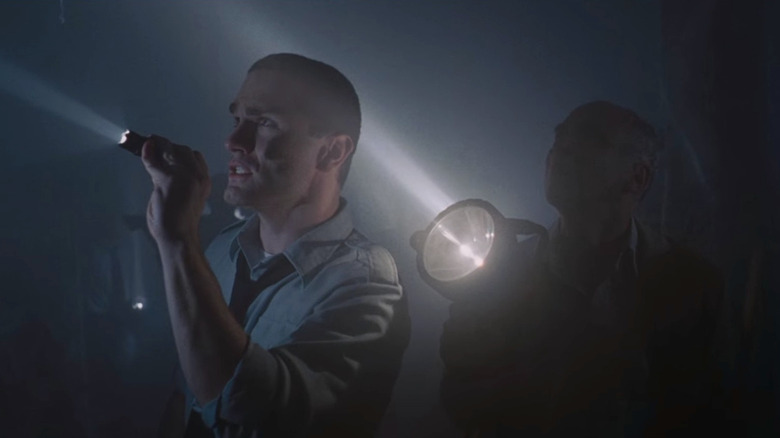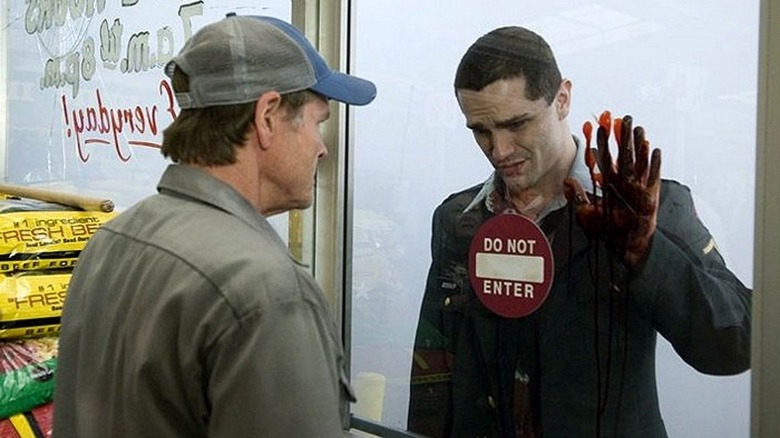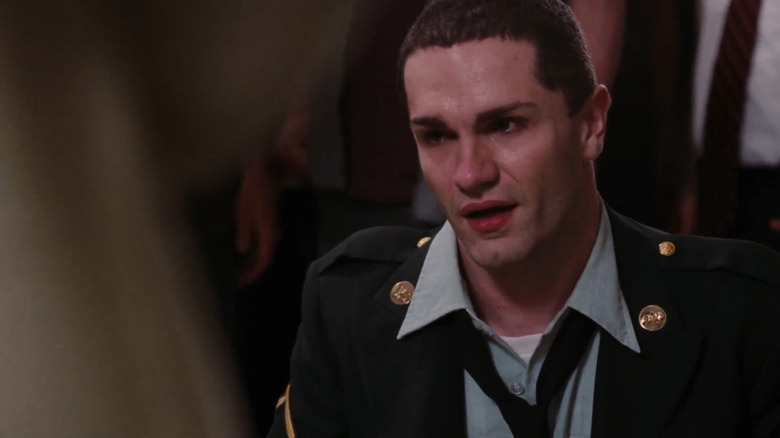Sam Witwer Personally Pitched His Own Death Scene In The Mist [Exclusive]
Fifteen years after its release, the Frank Darabont-directed Stephen King adaptation "The Mist" still stands the test of time. The horror flick more than delivers on its premise, with some gnarly creatures and a mystery-filled narrative. The clash between humans and monsters is not as simple as the bloody horror that follows them, too. Although the digital effects-heavy interdimensional bugs are fun to watch wreak havoc, it's the slow decay of its prominent humans that flips the term monster on its head.
The death of Private Wayne Jessup (Sam Witwer) near the climax of the film best showcases that moral corruption. To recap, Jessup ended up dying not just due to the massive insects, but the people stuck inside in the market. After revealing the truth behind the arrival of the monsters — it all has something to do with secret experiments going on at Jessup's military base _ the religious zealot Mrs. Carmody (Marcia Gay Harden) and others put the blame on him and offer Jessup up to the invaders as a sacrifice after stabbing him. The death is as brutal as it is emotionally devastating, a sign that the survivors are now worse than the monsters outside the windows.
In celebration of its 15th anniversary, Witwer revealed to /Film a number of neat tidbits about the low-budget production, including a hidden "Star Wars" reference, but also discussed his character's death scene. The final sequence involving Jessup feels intrinsically linked to the central message of the film — however, it was not in the original script. Witwer came up with it himself and took it to the man in charge.
'No, that's what we'll do'
On a busy day during production, Witwer decided that he felt compelled to tell director Darabont of an idea he came up with for Jessup's death. According to the actor himself, Witwer often rattled off "harebrained" ideas that never even got close to filming. However, this was not the case for his character's death. Despite Darabont being swamped with work, the director listened intently to Witwer's ramblings. During a break, Witwer pitched the scene we got in the final product:
"I'm bleeding, I turn, I see the monster and then, I turn very, very deliberately to [William] Sadler, place my hand, which has been– I've been trying to hold my guts together. I place my hand on the window and I just say "please." And then, I get pulled out into the mist by the monster and the handprint is all this left of me, the bloody handprint."
Darabont, convinced of its thematic weight and budget-friendly implications, approved the new scene immediately: "Yeah. No, that's what we'll do. Absolutely. That's much more uncomfortable." And boom, movie magic. That was not the only moment changed from the script, either. And it's great to hear that Darabont was open to the new scene — especially since the original was nowhere near as good.
More blood, less nuance
The original death in the script was meant to be bloodier and more appealing to shock value, according to Witwer:
"The script says I get yanked into the creature and blood and gore and body parts get sprayed across the whole window of the front of the grocery store. I'm like, 'That's really cool, but I think we've had that in this movie. I think we've done the fun horror movie thing. I think we need to make this a personal murder.'"
It would have been impactful to see the gory consequences of the characters' actions in full display. But the emotion Witwer brings to the new sequence is harrowing, to say the least. Focusing on his genuine plea for help in his final moments emphasizes the fact this was a murder committed by the survivors, as direct as any other in the film. The death sets the stage for the third act, which positions Mrs. Carmody as a villain none worse than the bugs attacking the market.
Even if we're still debating that controversial ending, at least the filmmakers stuck to their guns and delivered a film that consistently sought to add nuance to a monster-ridden affair.


